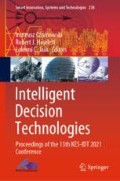Abstract
In the Internet era, the competitiveness of global building design smart technologies continues to increase, inevitably forcing smart building design to re-examine the application of smart systems, the development and evaluation of indicators, including the evaluation of biometric systems, radio frequency technology systems and digital cryptography. The system is used to improve the overall satisfaction and competitiveness of intelligent technology in architectural design. However, the successful design of intelligent architectural depends on the development of corresponding systems and the management of advantages. Thus, we via literature review to frame construction developing sustainability strategy indicators for this research that were divided into three major dimensioned which were further subdivided into twelve sub criteria; the propose to use a new sustainable development strategy indicator evaluation and intelligent technology architectural design improvement MADM-DANP model. Unlike previous multiple attributes, decision-making (MADM) methods that assume the criteria are independent, we propose a hybrid model, combining a decision-making trial and evaluation laboratory (DEMATEL) and analytical network process (ANP) method called DANP, which addresses the dependent relationships between the various criteria to better reflect the real-world situation. In the final results, we can also address a gap in the development of sustainable development plans for the environment, taking into account comfort, convenience and safety in order to raise the standards in achieving human welfare expectations.
Access this chapter
Tax calculation will be finalised at checkout
Purchases are for personal use only
References
Saaty, T.L.: Decision making with dependence and feedback: analytic network process. . RWS Publications: Pittsburgh, PA USA (1996)
Bart, M., Dirk, S., Hilde, B.: Analysing modelling challenges of smart controlled ventilation systems in educational buildings. J. J. Build. Perform. Simul. 14, 116–131 (2021)
Zhang, R., Jiang, T., Li, G.: Stochastic optimal energy management and pricing for load serving entity with aggregated TCLs of smart buildings: a stackelberg game approach. J. IEEE Trans. Ind. Inform. 17, 1821–1830 (2021)
Gupta, A., Badr, Y., Negahban, A., Qiu, R.G.: Energy-efficient heating control or smart buildings with deep reinforcement learning. J. Journal of Building Engineering 34, 101739 (2021)
Ge, H., Peng, X., Koshizuka, N.: Applying knowledge inference on event-conjunction for automatic control in smart building. J. Appl. Sci. Basel. 11, 935 (2021)
Smith, S.: ‘Intelligent buildings. In: Best, R., de Valence, G. (eds.), ‘Design and construction: building in value.’ J. Butterworth Heinemann, UK, pp. 36–58 (2002)
Wan, P., Woo, T.K.: ‘Designing for intelligence in Asia buildings,’ J. Proceedings 1st IEE International Conference on Building Electrical Technology (BETNET), IEEE, Hong Kong, pp. 1–5 (2004)
Wong, J., Li, H., Lai, J.: Evaluating the system intelligence of the intelligent building systems Part 1: development of key intelligent indicators and conceptual analytical framework. J. Autom. Constr. 17, 284–302 (2008)
Wong, J., Li, H.: ‘Development of a conceptual model for the selection of intelligent building systems.’ J. Build. Environ. 41, 1106–1123 (2006)
Chen, Y.C., Lien, H.P., Tzeng, G.H.: Measures and evaluation for environment watershed plans using a novel hybrid MCDM model. J. Expert Syst. Appl. 37(2), 926–938 (2009)
Tzeng, G.H., Chiang, C.H., Li, C.W.: Valuating intertwined effects in e-learning programs: a novel hybrid MCDM model based on factor analysis and DEMATEL. J. Expert Syst. Appl. 32(4), 1028–1044 (2007)
Author information
Authors and Affiliations
Editor information
Editors and Affiliations
Rights and permissions
Copyright information
© 2021 The Author(s), under exclusive license to Springer Nature Singapore Pte Ltd.
About this paper
Cite this paper
Chen, V.YC., Lin, J.CL., Wu, Z., Lien, HP., Yang, PF., Tzeng, GH. (2021). Assessment and Improvement of Intelligent Technology in Architectural Design Satisfactory Development Advantages Management. In: Czarnowski, I., Howlett, R.J., Jain, L.C. (eds) Intelligent Decision Technologies. Smart Innovation, Systems and Technologies, vol 238. Springer, Singapore. https://doi.org/10.1007/978-981-16-2765-1_24
Download citation
DOI: https://doi.org/10.1007/978-981-16-2765-1_24
Published:
Publisher Name: Springer, Singapore
Print ISBN: 978-981-16-2764-4
Online ISBN: 978-981-16-2765-1
eBook Packages: Intelligent Technologies and RoboticsIntelligent Technologies and Robotics (R0)

